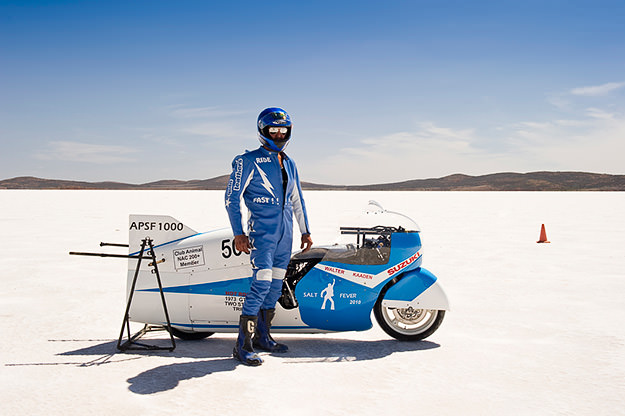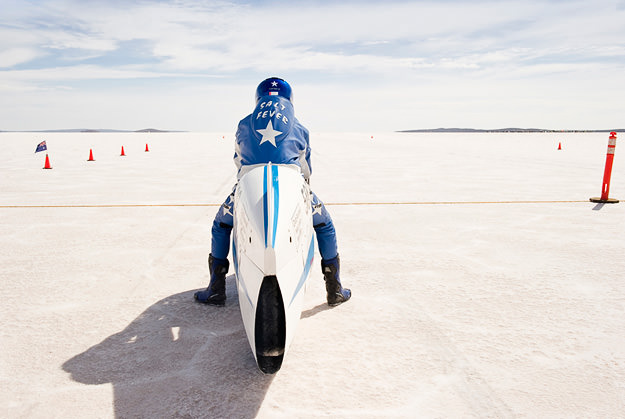
Brett Destoop is an interesting guy. He doesn’t own a road-registered bike, but a few days ago, he became the first man in Australia to go faster than 230 mph (370 kph) on a sit-down motorcycle. At the Lake Gairdner Speedweek meet, he rode his home-made ‘water bottle’ into the record books at exactly 232.108 mph.
Brett’s Suzuki runs in the APSF-1000 category, which means “A-frame special construct, partial streamline, fuel, 1000 cc”. It’s set not only an Australian record, but also eclipsed the next fastest time in its class—215mph, set by an R1 at Bonneville in 2004. The most amazing part is that the Maraylya man built the frame, fairing and most of the top end himself. The bike runs a 1973 Suzuki GT750 bottom end with a standard crank, upgraded big end bearings, and a strengthened clutch and gearbox. Brett cast the cylinders and pistons in his living room; he also made the heads, and welded and re-machined the crankcase. The bike runs on methanol and the frame is fully adjustable for rake and trail.
The images were shot by custom auto photographer Simon Davidson, who says: “Even though Brett only made a one way pass, I think it’s fair to claim a world record, if only for bragging rights. Brett describes a 200 mph run on his bike like flying a wing. Up to 180 mph he is only gaining enough speed for the bike to start to handle, and from there on in it’s flying … literally.”
“There are many other factors to consider like cross wind and the condition of the salt. If the bike gets out of shape at high speed, backing off on the throttle will buck you off. So, against all natural instincts, more throttle is the answer. Brett tells the story of how last year (at about 190 mph) the rear end was a little out of shape and he gently wound on throttle to bring the back end into line. Forgetting he was a gear lower, he hit the power band hard, spun the back wheel, changed gears and ran 210.169 mph. He described the moment as terrifying and exhilarating all at once.”
Speedweek is held annually at Lake Gairdner in South Australia, usually in March each year: a run on the salt involves three miles of run up, before you get timed over three one-mile gates. For more information, check the Dry Lakes Racing Association website. [Many thanks to Simon Davidson: see more of his work on his portfolio website.]

